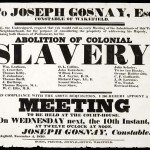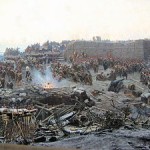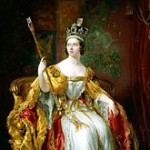5.3- Influences During the Romantic Era
Politics
Industrial Revolution Continues
[audio:IndustrialRevolution.mp3]
- Trains
- Steamships
- Bicycle
- Increasing urbanization
- Need for a concentrated work force
- Need to be near raw materials
- Need to be near transportation hubs
- Gas lamps for street lighting
- Communication
- Telegraph & telephone
France
[audio:France.mp3]- 1804 Napoleon is Emperor
- 1814 Napoleon is ousted
- 1814-1830 The Bourbon Dynasty holds the throne in France
- 1830 — Charles X is overthrown in “The July Revolution’
- 9 Street riots in Paris between 1830-1848 — Second Republic is established
- 1870 Haussmann completes the rebuilding of Paris
- Infected alleyways and centers of epidemics destroyed
- Wider streets — Grand boulevards
- New water and sewage systems
- The poor and working class are evicted to the suburbs
- Upper bourgeois strolling become vogue as a result
- 1870-71 Franco-Prussian War
Abolitionism
- Europe and America
- Implications for the Caribbean and South America as well
America
[audio:America.mp3]Russia
[audio:Crimeanwar.mp3]- 1853-56 Crimean War – Russia allied with France and Britain against the Ottoman Empire
- Fought on the Crimean peninsula — now part of modern day Ukraine
Germany
[audio:germany.mp3]
Britain
[audio:Britain.mp3]Religion
Emancipation of Jewish society in Europe
[audio:Jews.mp3]Artists, musicians and writers capitalize on the “God granted’ abilities
[audio:Religionstillthere.mp3]Recognition that the more we know, the more we realize there is more that is unfathomable
Romantic era writers capitalize on conflicts within the human mind and heart as well as on our ignorance of things.
The mystical and mysterious is celebrated.
Nature is depicted as evidence of God’s Bounty.
Sciences
[audio:Science.mp3]Louis Pasteur 1822-95
- French
- The study of micro organisms
- Understanding how disease is spread
- Sterile practices
- Pasteurization of milk
Charles Darwin 1809-82
- English
- On the Origin of Species
- The theory of evolution based on natural selection
Sigmund Freud 1856-1939
- Born in Moravia, lived in Vienna
- At the turn of the century he begins to publish his theories
- Develops the concepts of psychoanalysis
- Splits the human psyche into the ego, the id and the super ego
Paint Technology
Improvements in how paints were stored made painting out of doors much easier
Architecture
[audio:neogothicandbaroque.mp3]Neo Gothic
- BritishParliament 1836
- Gothic revival was strongest in England
- Meant to evoke the spiritual and ethical values of the Middle ages
Neo Baroque
- Charles Garnier — Opera House Paris 1861-1874
- Meant to emulate extreme sumptuousness
Industrial Developments
[audio:innovations.mp3]- Cast Iron
- Steel
- Formed concrete
Crystal Palace — built for the Great Exhibition of 1851 in England
Please explore the link for this amazing building that did not withstand the test of time.
- Joseph Paxton — gardener to the Duke of Devonshire
- Prefabricated, modular cast iron frame work
- Supporting over 900,000 square feet of glass
- This model was quickly adapted to railway stations and other large spaces
- Crystal Palace was destroyed
Louis Sullivan 1856-1924
American
- Commercial buildings reinforced with steel and formed concrete
- Allowed for building higher
- “Form follows function’
- Buildings should elevate the spirit of those who worked in it
- Wainwright Building
Frédéric-Auguste Bartholdi — Statue of Liberty 1886
French
- Collaborated with Gustave Eiffel
- Over 150 feet tall
- Gift from France to America
Eiffel Tower – Gustave Eiffel
- Built in 1889
- A demonstration of engineering technology
- A short lived style
- Influenced by nature
- Decorative features that included curving lines, like plant foliage






 |
|
No. 1 — July 12th, 2010 at 8:41 pm
The link for the British Parliament under architecture does not work
No. 2 — October 16th, 2010 at 11:32 pm
I found this to be so as well. Along with other links in previous sections.
No. 3 — March 1st, 2013 at 12:02 pm
Hello there, simply become aware of your blog via Google, and located that it’s really informative. I’m gonna watch out for brussels. I will appreciate if you continue this in future. Many other folks will probably be benefited out of your writing. Cheers!
No. 4 — May 27th, 2013 at 11:06 am
Oh my goodness! Impressive article dude! Thank you, However
I am going through troubles with your RSS. I don’t understand the reason why I can’t join it.
Is there anybody else getting the same RSS problems?
Anybody who knows the solution can you kindly respond?
Thanks!!
Also visit my blog post … Archie
No. 5 — August 22nd, 2014 at 4:25 am
You actually make it seem so easy with your presentation but I find this matter to
be really something that I think I would never understand.
It seems too complex and extremely broad for me.
I am looking forward for your next post, I’ll try to get the
hang of it!
No. 6 — September 26th, 2014 at 11:47 am
I do not even know how I ended up here, but I thought this post
was great. I don’t know who you are but definitely you
are going to a famous blogger if you are not already
😉 Cheers!